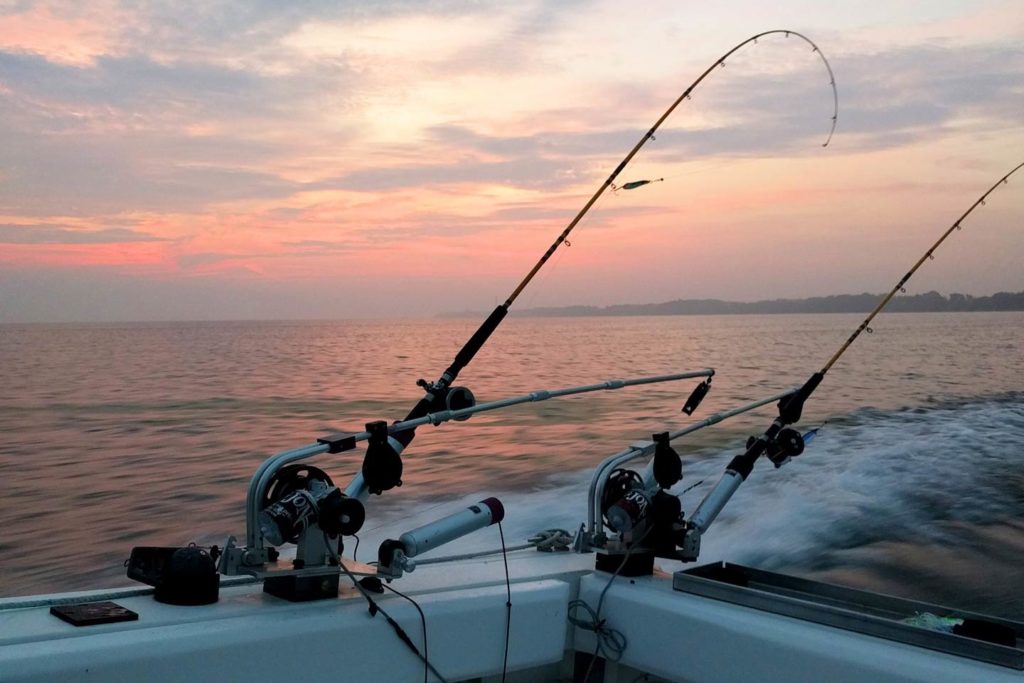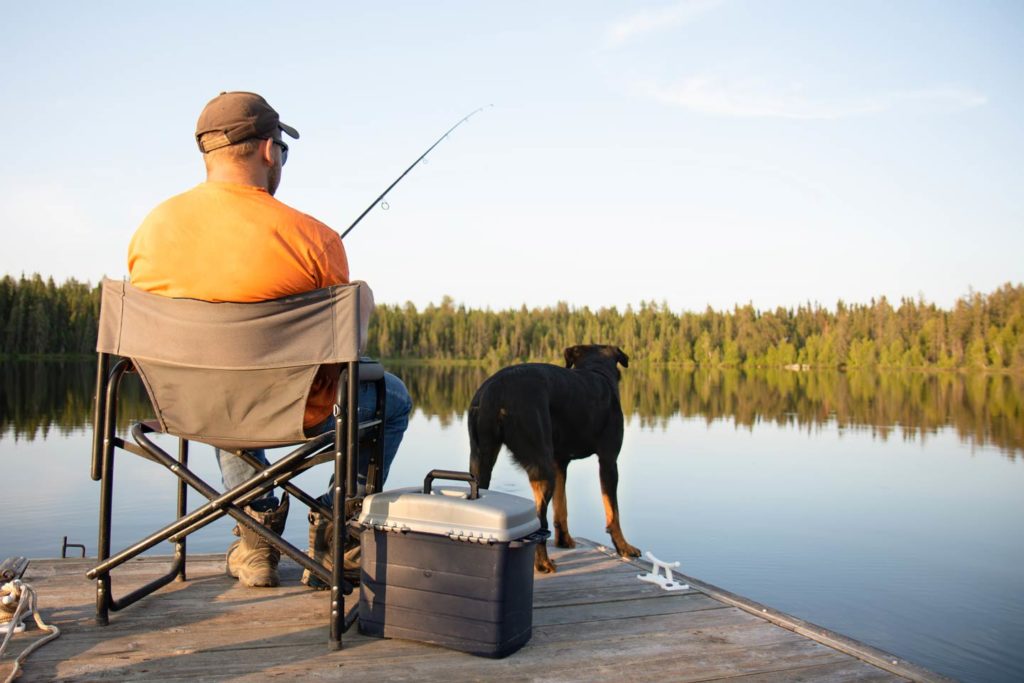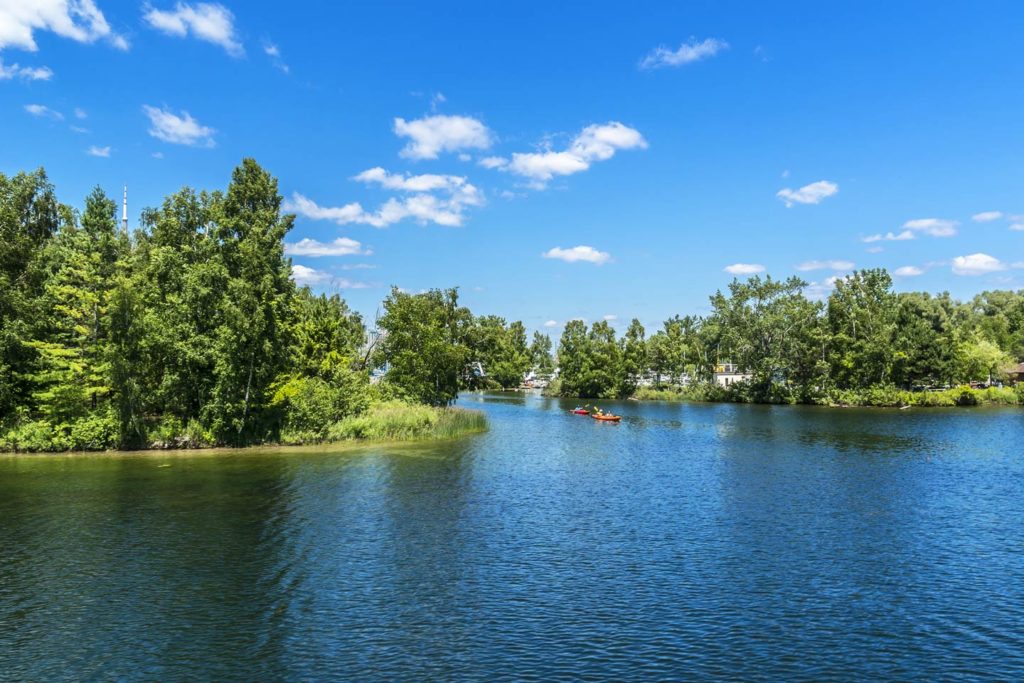Lake Ontario is the smallest of the Great Lakes, but that doesn’t diminish how fantastic the fishing here is. In fact, when you head out on a Lake Ontario fishing trip, you’re getting the best of what all of the Great Lakes have to offer. Why? It’s simple. The four remaining lakes all flow into Lake Ontario before it empties out into the Atlantic Ocean.
As a result, the lake is something of an ecological wonder. It supports a diverse range of wildlife and very big fish. Not to mention that it’s a source of drinking water for over nine million people. However, the lake has suffered on account of overfishing and pollution. Great efforts are being implemented to restore its biodiversity, ensuring we can enjoy it for many more years to come.
With New York state lying to the south and the Canadian province of Ontario to the north, it’s easily accessible to a variety of anglers. Read on to find out what fish to target, where to go, and how to make the most of your adventure.
Best Fish to Catch in Lake Ontario
If you’re a freshwater sport angler, this list of fish is going to make you very happy. There are plenty of opportunities to hook into delicious species to take home. If you’re hoping to break a personal best, the lake also breeds quite a few trophy fish.
Salmon

These pink-fleshed creatures are by far the number one target anglers come to Lake Ontario for. And while there are a few varieties of Salmon you can go after, Chinook Salmon are the kings of these waters. These fish check all the boxes. They put up a tremendous fight and taste delicious! Since you won’t find them here year-round, we’ll address seasonality first.
Chinook Salmon start to congregate in the western ends of the lake in spring. As temperatures rise, they move into deeper and colder waters. They’ll stay here until late August or September, before heading into the tributaries to spawn. This is game time! The fish are hungry, aggressive, and eager to attack your line.
How you’ll fish will depend on the time of year. In the summertime, when the fish are in deeper water, you should try trolling. Once the Salmon move into the lake’s tributaries, you can continue trolling or try drift fishing, fly fishing, or spinning. Later in the season, keep an eye out for Coho Salmon and, less often, Atlantic Salmon.
Lake and Brown Trout

Salmon may take center stage but it would be a shame to overlook the incredible Trout fishing in Lake Ontario. Come spring, Brown and Lake Trout rule these waters. If you’re after delicious Brown Trout, head to the lake’s shorelines or the mouths of the tributaries. These creatures prefer warmer waters and a simple spinning or trolling set up is usually enough to get you on some fish.
Lake Trout are even easier to catch and a great target for novice anglers. Head into colder waters and cast your lures very close to the bottom. As long as you get the depth right, there’s bound to be fish nearby. Lake Ontario is also a great place to head if you’re after a trophy. Lake Trout in the 30–40 pound range are regularly caught here! The bigger fish don’t taste great, so it’s best to snap a photo and release your prize.
Steelhead

Steelhead fishing mainly happens in Lake Ontario’s tributaries. These migratory Trout are some of the hardest fighting creatures, which plays a big part in why anglers love to go after them. There are two varieties of Steelhead in Lake Ontario: Washington and Skamania. Their main differences lie in their respective seasonalities.
In the winter, you’ll take advantage of the Washington run, whereas Skamania make a summer run. “Run” refers to the time of year when these fish spawn. This is when they’re at their hungriest and most aggressive.
There are a couple of different ways to target Steelhead. Float and drift trips, fly fishing, and spin fishing are all popular methods. What lures you’ll use will depend in part on your fishing method but crankbaits and spinners are surefire choices. You may also want to try your luck with roe bags.
Walleye

Yep, you can catch these freshwater legends in Lake Ontario too! Walleye keep anglers on the lake busy year-round. Winter anglers will be happy to hear that Walleye fishing is at its finest during the colder months and make for great ice fishing targets, too. Most fish are in the 1–3 pound range, but it’s not uncommon to catch 10-pound whoppers.
As soon as you locate one Walleye, there are bound to be more nearby. These are schooling fish, so toss out a marker after you’ve landed your first catch of the day. Walleye prefer low light and most anglers do their vertical jigging or trolling after dark. That doesn’t mean you won’t catch any fish during the day, though. Just seek out deeper water and rocks or weeds where they may be hiding.
Pike

Here’s another year-round target to add to your list. Northern Pike are widely distributed across Ontario and upstate New York, including Lake Ontario. Like Walleye, these are cold-water fish, and the warmer it gets the deeper you’ll have to go to find them. Unlike Walleye, they’re solitary hunters focused on locating their food source.
It won’t take you very long to find one though, as these fish are extremely aggressive and opportunistic eaters. “Eyes bigger than their stomachs” is another attribute we can give them. Don’t be afraid to use a big, bright-colored lure to draw their attention. Whether you’re trolling, spinning, or ice fishing, a fluorocarbon leader is non-negotiable. Their razor-sharp teeth will cut straight through anything else!
Bass

Lake Ontario fishing trips can put you on Largemouth and Smallmouth Bass. These fish are a favorite with sportfishers across the board for a number of reasons. You don’t need a complicated setup and these creatures put up a great fight. Heading into Lake Ontario’s eastern basin is a great place to start if you’re hoping to hook into some Bass.
Bass fishing on Lake Ontario is a summer sport. The season typically kicks off in the late spring and lasts until early fall. Fish in the early morning or late evening for best results – these fish tend to shelter during the day. If you aren’t having much luck, try changing your lure. Bass are intelligent and have a keen sense of smell – they often won’t go after the same bait or lure twice.
How to Fish Lake Ontario
There are a few different ways to embark on a Lake Ontario fishing trip. Some depend on seasonality and others on your chosen targets. Take a look at some of the most popular ways to fish the lake below.
Charter Boat

For trophy catches, filling the freezer, and hitting multiple spots, you can’t beat charter boat fishing. It may be the smallest of the Great Lakes but Lake Ontario is still a large body of water. On a charter boat, you’ll have the freedom to move around and change spots quickly in pursuit of your targets.
You’ll also have a local captain on hand who most likely fishes the lake year-round and possesses serious knowledge of the waters. If you’re unfamiliar with the area, this is a huge benefit. More often than not, your gear and bait will be included in the price of a charter. All you’ll have to worry about is purchasing a fishing license (more on that later).
Shore Fishing

Sure, charter boat fishing is the best way to get your fill of fish to take home. If you’re just looking to have some fun, though, fishing from shore is the way to go. Set up a chair and your gear along the shorelines of Lake Ontario and relax. It’s also great for kids. You’ll be on firm footing when teaching them the ropes and there’s plenty to explore nearby if anyone gets restless.
What’s more, you can catch a variety of fish! Largemouth and Smallmouth Bass, Perch, Walleye, and even Pike are all possible catches. To up your chances of hooking fish, try to set up near structures like bridges. There are usually deep pockets of water around them, which draw in small baitfish and larger predators in search of their next meal.
Ice Fishing

The fact that it’s winter doesn’t mean you have to stop fishing! Whether you’re fishing on the Canadian or American side of Lake Ontario, you’ll find areas with world-class ice fishing. Lake Ontario is deep and so it very rarely fully freezes over. Stick to the shorelines and slack water bays where the water is shallower and the ice is thick enough to fish safely.
Ice anglers come to Lake Ontario from far and wide to hook into the likes of Northern Pike, Walleye, and Perch. Chaumont Bay, Guffins Bay, and the Bay of Quinte are a few places that offer great ice fishing on Lake Ontario. Just remember – ice fishing conditions can change overnight. Always make sure the ice is safe before drilling, dress warmly, and bring a cellphone or radio with you.
Lake Ontario Fishing Spots

This is a tough one. There are so many great places to cast a line in Lake Ontario! Below are just a few of our favorite angling destinations to get you started in choosing a spot to fish.
- Pulaski: Mention Lake Ontario fishing to experienced anglers and they’ll immediately tell you to go to Pulaski. Offering access to both the Salmon River and Lake Ontario, it’s one of the best places to get your hands on Chinook and Steelhead when the season hits.
- Oswego: Lake Ontario, the Salmon River, and the Oswego River are all fishable if you head out of the town of Oswego. This is where you want to be for Chinook and Coho Salmon, Steelhead, and Brown Trout.
- The Bay of Quinte: This bay on the Canadian side of the lake offers some of the best year-round Walleye fishing there is. Pike, Bass, and big Perch are on the cards too. Here in the winter? Don’t miss out on a chance to go ice fishing.
- Niagara County: Head out onto Lake Ontario or explore the Niagara River from one of many towns on both sides of the border. Depending on where you’re fishing, you’ll encounter Salmon, Trout, Bass, and Walleye.
- Rochester: Lake Ontario’s waters are deep near Rochester. There’s also Sodus Bay and the Finger Lakes to dip your rod into. You can find Salmon, trophy Trout, Walleye, and Bass here.
- Greater Toronto Area: Looking to do some urban angling? Toronto has got you covered. Cast a line in Mississauga’s Port Credit, Ashbridges Bay, or Oakville and you could hook into Brown Trout, Bass, Pike, and even Salmon!
Lake Ontario Fishing Regulations
Before you get out onto Lake Ontario’s waters, it’s important to get acquainted with the fishing rules and regulations. These will differ depending on whether you’re fishing on the American or Canadian side of the border. Below, we highlight what you need in both cases.
Fishing in American Waters

If you’re fishing the American half of Lake Ontario, the first thing you’ll need to do is buy a New York State fishing license. There are a few different options for freshwater licenses, which you can see in more detail here. Likewise, the lake and its surrounding tributaries are subject to strict possession and size limits. Be sure to inform yourself before heading out.
Fishing in Canadian Waters

Much of the same applies when fishing in Canadian territory. Anglers between the ages of 18–65 are generally required to carry a valid Ontario fishing license, though veterans and active members of the Canadian Armed Forces are exempt. Before you can buy a fishing license, you’ll need to purchase an Outdoors Card. However, you can get a single-day fishing license without an Outdoors Card.
Lastly, if you plan on dipping your rod into waters on both sides of the border, you’ll need to buy both an Ontario and New York fishing license. Don’t forget your passport, either.
Lake Ontario Fishing: Experience Greatness

Fishing the Great Lakes is a special experience. And perhaps we’re biased, but we think Lake Ontario is extra special. With incredible Salmon and Trout fisheries and a mix of stunning natural landscapes and cosmopolitan cities along its shorelines, there’s something for everyone.
What are your favorite Lake Ontario fishing spots? Any tips to share with your fellow anglers? Let us know in the comments – we love to hear from you!